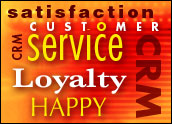
Many companies question if the dollars spent with research and advisory firms are delivering unbiased, accurate guidance. This is particularly true in the CRM industry, where analysts influence short lists, sales cycles, and media coverage extensively. Analysts, in short, can make or break a start-up company relatively quickly.
Getting to the truth about industry analysts starts by debunking a few myths.
Myth 1: IBM, Microsoft, SAP, Siebel, PeopleSoft and Oracle spend millions on analyst relations and, as a result, get the best coverage.
Reality: If you go and visit each of these companies’ CRM divisions, a SWOT analysis (strengths, weaknesses, opportunities and threats) comes percolating up after even half a day spent in briefings. Each of these companies is well-aware of its strengths, yet does not have the ability to look at itself from the outside and see its weaknesses in the context of the CRM industry. That’s what industry analysts are best used for from the vendor side — getting them to tell you your weaknesses and the areas of improvement needed.
Ironically, some of these companies are so enamored with their own strengths that it becomes very difficult for them to see their own weaknesses. Visits into these companies as an analyst has a cultish feel: You can say anything as long as it is politically correct and not too confrontational.
Myth 2: You can buy your way into deals with CRM industry analysts.
Reality: This is like saying you can buy yourself a low cholesterol score if you pay your physician enough. No matter how much you pay, your past is reflected in the present. No one buys their ways into deals; you earn your way into them with strong customer references, consistent briefings, constant requests for feedback on direction and generally a partnering with — and not a talking at — analyst attitude in the company.
Myth 3: Analysts do not have favorite CRM vendors.
Reality: It’s human nature to prefer one person, group of people, company or subject to another. So does this cross the line of ethics? Only if the analyst doesn’t have enough self-awareness to check his or her perceptions in light of what his or her user clients need.
Analysts do have favorite vendors, and in hardware industries it’s common for senior researchers to start their presentations by explicitly stating their favorite vendors. I recently attended a research conference and a VP-level researcher started his presentation on hardware by saying which vendors he admired and why. Favoritism happens.
Myth 4: ‘Analyst Relations’ is another word for lead generation.
Reality: If this were the case, the cost per lead would be astronomical. Analyst relations is a very poor method generate leads — one of the lowest performing any company could pursue. It is a very poor use of resources to pay analysts just to evaluate them for leads.
Myth 5: The more I spend, the more positive the analysts will treat me.
Reality: This is the philosophy of CRM vendors who have this cultish approach to analyst relations, where anything negative must be wrong. In fact, the more you spend with analysts as a vendor, the more thorough the insightful feedback, both good and bad, should be forthcoming.
If all you get is positive feedback, fire the analyst firm and use half the budget for PR; it’s cheaper and you are getting the same result. Why? Because analysts should know enough about your company to know the good and the bad and be able to guide you around the weak areas.
Drastic Changes
The world of CRM is going to change drastically in the coming three years as Microsoft patiently builds out its CRM strategy, and as SAP, Siebel, Oracle and PeopleSoft each continue to realign their applications to match how people work.
Underscoring all this is the currency vendors trade with reference accounts — with measurable results. Add in a CEO who has skin in the game and is more concerned about visiting customers in the middle of implementation — versus doing merger-and-acquisition deals — and can speak with depth of experience on their company’s strengths and weaknesses, and then a vendor has the beginnings of a good analyst-relations program.
For users, reference other companies to which your analyst has recommended software. That can tell you a lot about short-list preferences of the analyst you are dealing with.
Louis Columbus, a CRM Buyer columnist, is a former senior analyst with AMR Research. He currently works in the software industry and recently published the e-book Best Practices in Industry Analyst Relations, which is available on Amazon.com.
This story was originally published on June 18, 2004, and is brought to you today as part of our Best of ECT News series.

















































Social CRM
See all Social CRM